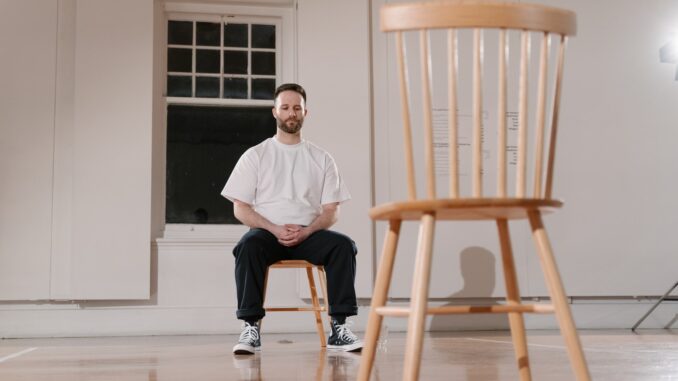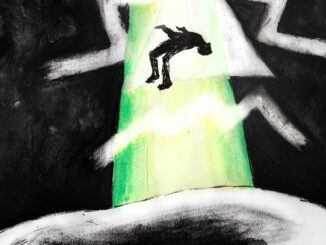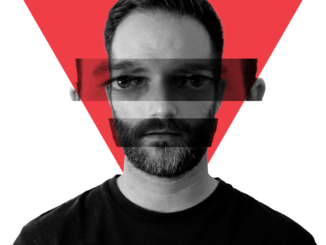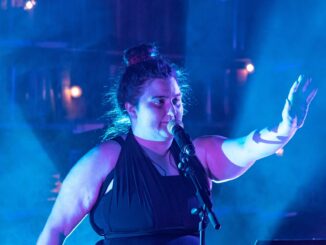
[Emotions Laid Bare]
I walk into Freyberg Place and see a large sign being put up on the outside of the Ellen Melville Centre. It outlines the instructions for participating in Access – sit opposite the performer, choose an emotion from a menu of six, and stay as long as you like. I watch as the space is prepared: a white square marks the bounds of the performance space and the distance between two chairs is precisely set by creator and performer Hamish Annan. When it’s time for the show to begin, a few of us hesitantly approach. A welcoming guide is there to greet us and explain the rules. No one wants to be the first to try this strange experiment, so I take the plunge. I request grief.
Annan dives straight in, taking me on a journey of bald-faced despair and loss, and it is confronting. I clutch my hands together and laugh nervously. I’m aware of the others watching, of the exposed, public nature of the setting. Yet, at the same time, Freyberg Place has melted away and there are only Annan’s magnetic eyes and our two bodies in space. Eventually, my breathing gets heavy, in sync with Annan’s, and I want to escape. As soon as I step out of the space, a warm release greets me and I feel calmer, like I’ve gone through something and come out the other side.
I watch as others take a seat and request different emotions. Annan is always responsive to the person sitting opposite him, playing up or down depending on what they give him. He does not so much perform these emotions as access them – finding them in the person he’s with. I feel like a voyeur watching these private exchanges, but I also know from being in the chair myself that there is an energy in the space between Annan and the individual that only they are privy to – have access to, if you will.
Made in collaboration with Katie Burson and Rob Byrne, Access is a performance art piece first staged at Studio One Toi Tū and the Ellen Melville Centre as part of Auckland Fringe 2022. Though I did not see the original season, I think the outdoor location works best for the piece. It allows many more to have access to it. Indeed, by the end of the 60 minutes, a small crowd had gathered, and people who had never even heard of the show were participating in it. QR codes for NZSL interpretation are posted on pillars by the performance space. True to the show’s title, accessibility was clearly something its creative team prioritised.
Access is a piece full of contradictions. It is at once intimate and expansive, public and private. We as the audience are both passive spectators and active participants. We are connected to the performer in a way unlike any other and we are also alienated from him, from his true thoughts and feelings towards us. It is real and it is performance. Everything about the structure of the piece – from its clear rules to the physical distance between performer and participant – is designed to keep everything safe and consensual. But it is undoubtedly a scary and vulnerable experience.
It is perhaps a meditation on the public sphere as a whole. It is about finding a deep connection with a stranger and giving everyone access to raw, authentic emotion. It challenges the boundary between public and private, bringing the sacred and intimate into the public realm and turning the public space into one of personal connection. Before the show began, Freyberg Place was full of small groups and individuals all disconnected from one another. As so often happens when we’re in public, we hide ourselves behind our phone screens, disappearing into our own world – one that is hyperconnected in every moment, yet mostly devoid of emotion. It is understood that we should stay in our own bubbles, that we shouldn’t be too loud or draw attention to ourselves. Annan’s bold emotional displays upset this. And, by the end of the show, people from all backgrounds have been brought together and are having discussions about their experience.
In today’s technology-driven and politically polarised world, it is perhaps more important than ever that we have opportunities to connect without words, without context and without judgement. Theatre (and art in general) has always been a space where we are allowed to experience and express our emotions. Access takes this and pushes it onto our everyday lives, pointing to the arbitrary way we designate certain spaces for certain things, and destroying this with its liminality. It strips away story and character, lighting and sound, to give us what we really crave – emotional catharsis.
I sat in the chair a second time (you can go up as many times as you like over the hour, and come and go as you please). This time, I asked for lust. Perhaps this emotion was more comfortable for me or maybe I was just more ready to let go, but this time I felt Annan’s responsiveness to me more keenly. I smiled and he laughed and I laughed and we laughed together, over nothing really – just the pure exchange of energy between us; glorious.
Access encourages us to remember the important things in life and challenges us to be authentically emotional no matter what space we are in. It asks us what it really means to connect with others, what it means to exist as an emotional being.
Queerness is enacted in the piece by Annan’s (a gay man) mere presence. Emotional display is banned in the realm of traditional masculinity, but queerness has been challenging this for decades now. Indeed, Pride is a time where typically repressed emotions and experiences are celebrated. It is a time where normally private sexual proclivities are put loudly on display in the public arena. So, Auckland Pride is a fitting time for Access to return to the streets of Auckland. I only hope it can exist in more times and on different streets, so that more people can have access to the beautiful discomfort and transgressive power of this work.I highly recommend you take the opportunity to see the second showing of Access this Pride. Sit in that chair and let yourself experience something, whatever that may be.
Access plays Ellen Melville Centre 4th and 11th February as part of Auckland Pride.
This review is part of the Auckland Pride Review Project – a collaborative project between four local publications (The Pantograph Punch, Bad Apple Gay, Rat World and Theatre Scenes) to provide more critical discourse around queer theatre and performance work. We will be reviewing a range of shows throughout the month of Pride – so keep a look out and go support our local queer performers!




Leave a Reply